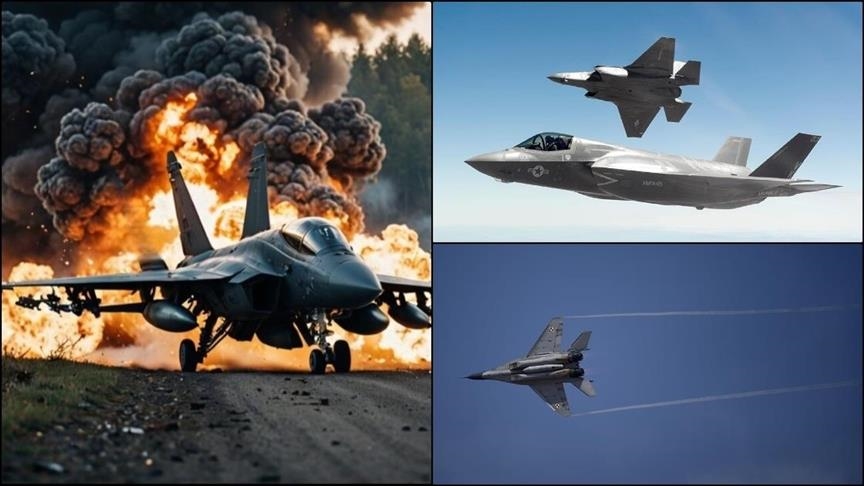- At least 12 accidents since 2018, along with ongoing concerns about reliability, maintenance, project delays, and cost overruns, continue to raise questions about the viability of the F-35 program
The author, with his experiences in Leonardo Helicopters, Piaggio Aero and Meritor, is a senior aerospace expert.
ISTANBUL
On Jan. 28, 2025, an F-35A fighter jet crashed at the Eielson US Air Force Base in Alaska during a training session. This incident has once again drawn attention to the issues of the safety, reliability, and operational readiness of this debated aircraft. Fortunately, in this case, the pilot ejected safely after experiencing an in-flight malfunction and was in stable condition after the crash.
A debated project
The F-35 Lightning II is a fifth-generation fighter jet developed by US aerospace giant Lockheed Martin, with its first flight in December 2006. It represents a major advancement in military aviation, featuring cutting-edge stealth capabilities, advanced avionics, and modern weaponry. However, it is a relatively heavy platform with a distinctive small-wing design. Over 1,000 aircraft have been delivered so far to the US military and to the global partners. However, at least 12 accidents since 2018, along with ongoing concerns about reliability, maintenance, project delays, and cost overruns, continue to raise questions about the viability of the F-35 program and the future of manned fighter aircraft in general.
Just last November, US entrepreneur Elon Musk commented on a video posted on X, showing hundreds of small drones in formation. He stated verbatim: “Meanwhile, some idiots are still building manned fighter jets like the F-35.” He elaborated: “Manned fighter jets are obsolete in the age of drones anyway. Will just get pilots killed … Crewed fighter jets are an inefficient way to extend the range of missiles or drop bombs. A reusable drone can do so without all the overhead of a human pilot.”
Musk, known for his bold statements, raised a valid point. Drones are rapidly transforming the landscape of defense operations. For example allowing nations with limited budgets to acquire reconnaissance and air defence systems that are not too expensive and are quite effective.
The F-35: Incidents and historical context
The January crash is the latest in a series of incidents involving the F-35. Due to the classified nature of military investigations, detailed information on the causes is not always readily available. Available reports suggest that most issues stem from the aircraft’s complexity. The F-35 processes vast amounts of data, which can be overwhelming for pilots, or experiences failures in critical systems. Here are a few significant examples:
- In May 2020, an F-35A from the 58th Fighter Squadron crashed while landing at Eglin Air Force Base. The accident was attributed to a combination of pilot error induced by fatigue, a design issue with the oxygen system, the aircraft’s complex nature, a malfunctioning head-mounted display, and an unresponsive flight control system.
- In January 2022, a South Korean Air Force F-35A made a belly landing after all systems failed except the flight controls and the engine.
In both cases (and in most incidents involving the F-35), the pilot survived.
Reliability and maintenance challenges
Beyond these incidents, the F-35 fleet has struggled with reliability, maintenance issues, and delays in deliveries. The Annual Report for Fiscal Year 2024, published in January 2025 by the Pentagon’s test director states that “the F-35 program has shown no improvement in meeting schedule and performance timelines for developing and testing software designed to address deficiencies and add new capabilities.”
Earlier in April 2024, the Government Accountability Office (GAO) of the US published a report titled “F-35 Sustainment: Costs Continue to Rise While Planned Use and Availability Have Decreased.” It emerges that “projected costs for sustaining the F-35 continue to increase while planned use of the aircraft declines” and that the F-35 fleet’s “overall availability has trended downward considerably over the past five years, and none of the variants of the aircraft are meeting availability goals.” The F-35 fleet’s mission-capable rate was significantly below program goals. The report attributed this shortfall to maintenance and repair issues, noting that the aircraft takes long repair time due to the failure rate of critical parts.
Delays in delivery
Meeting delivery deadlines also appears to be a weak point of the F-35 program. Recently, it has been hit hard by delays with its Tech Refresh 3 (TR-3) upgrade, which provides features such as improved processing power to facilitate a suite of new capabilities known as Block 4. The first F-35s that were supposed to feature the TR-3 upgrade began rolling off Lockheed Martin’s assembly line in Fort Worth, Texas, in July 2023. But the US Department of Defense has refused to accept their deliveries.
Factors Contributing to the F-35’s issues
What are the main factors that most likely contribute to the F-35’s challenges?
The F-35’s advanced systems and capabilities make it one of the most complex fighter jets ever built. The aircraft is often referred to as a “flying computer”: it is equipped with numerous sensors, processing systems, and integration capabilities that handle a vast array of signals. This complexity can lead to unforeseen technical issues and complicate maintenance procedures. Additionally, as highlighted in the GAO report mentioned above, the F-35 program has faced challenges with the reliability and maintainability of parts, leading to longer repair times and reduced aircraft availability. Furthermore, critics argue that the F-35 program moved too quickly from development to production, leading to the discovery of deficiencies during operational use.
Lockheed Martin position
On Jan. 8, Lockheed Martin summarized the progress of its F-35 Lightning II program, highlighting significant achievements despite recent challenges. The manufacturer has delivered 110 F-35s in 2024 and nearly 1,100 worldwide across all variants. The program’s fleet has accumulated nearly a million flight hours. “Lockheed Martin is fully committed to advancing and delivering unmatched air dominance solutions to the United States and our allies, helping to ensure America continues to own the skies,” the company has said in a statement.
What’s next?
While the F-35 represents a leap forward in fighter jet technology, its safety record and maintenance challenges cannot be overlooked. The series of accidents since 2018 underscores the need for thorough investigations and prompt corrective actions. Addressing the root causes of these incidents, learning from pilots’ operating experience, improving parts reliability, and enhancing maintenance procedures are essential steps to ensure the F-35 fleet’s smooth operations. As the program progresses, it is imperative for the Department of Defense and industry partners to prioritize these issues to fulfill the aircraft’s promise as a cornerstone of modern air combat (along with unmanned aircraft?). ( Source: Anadolu News Agency)


